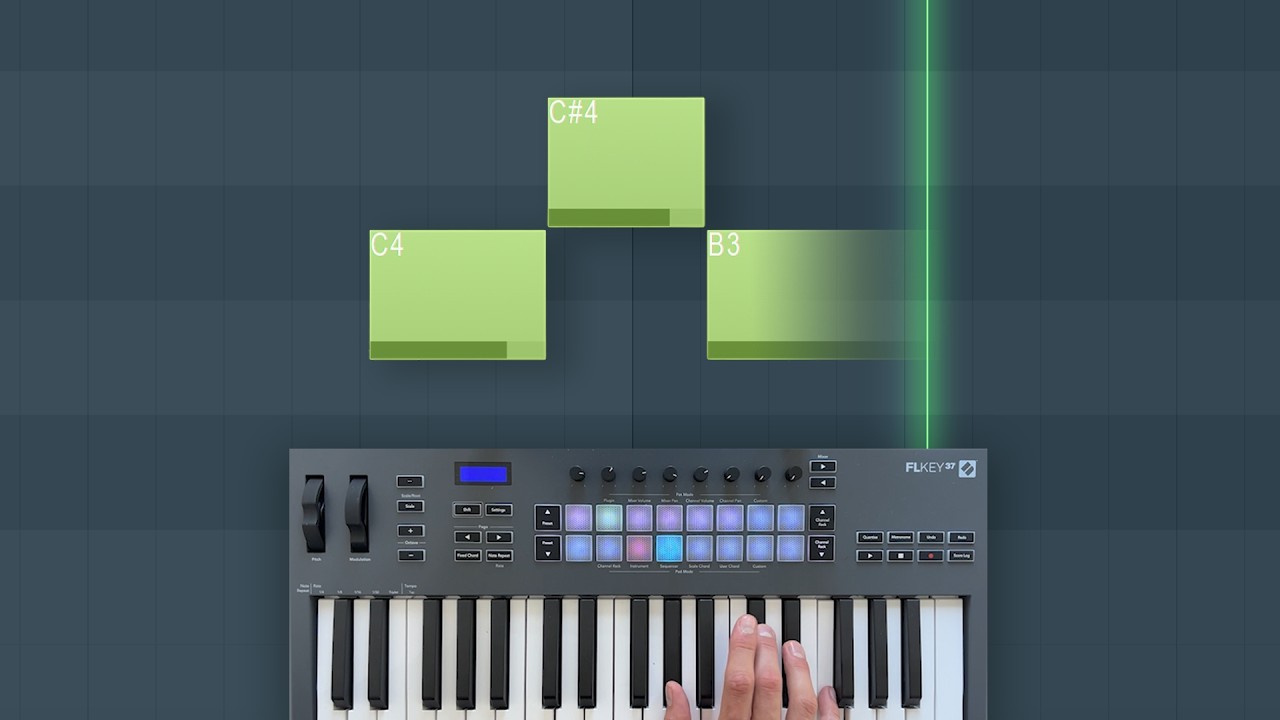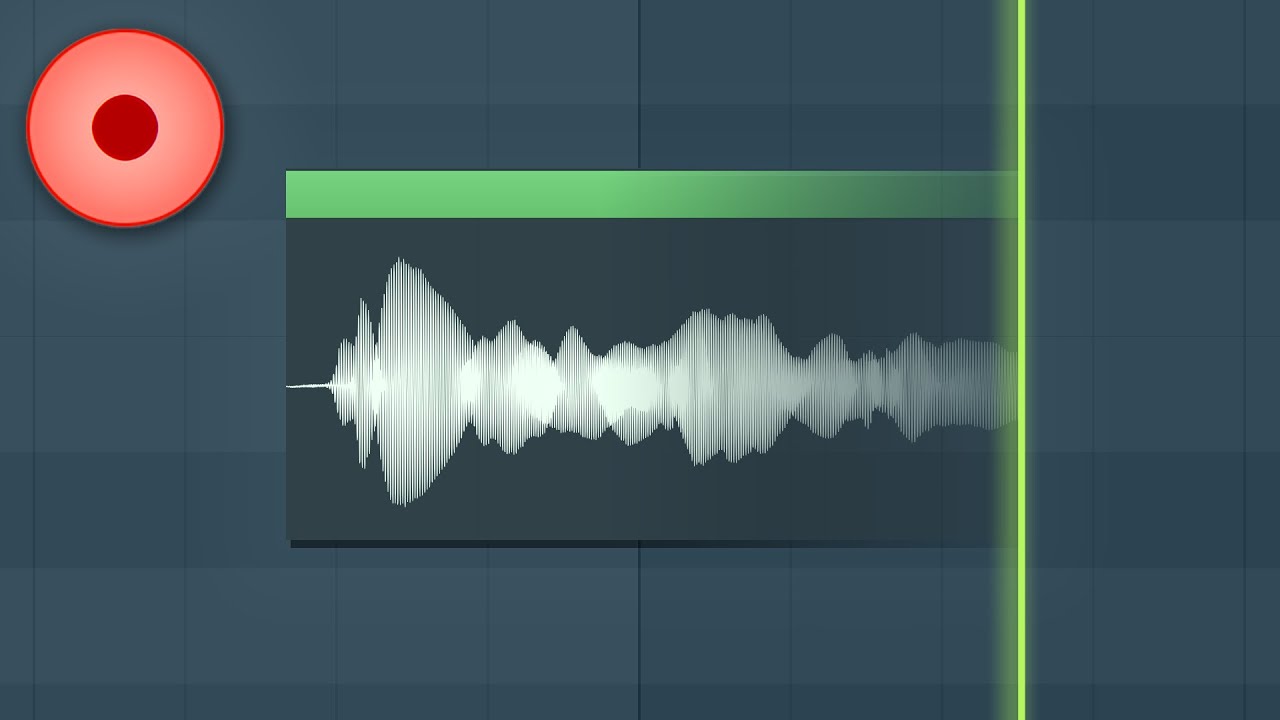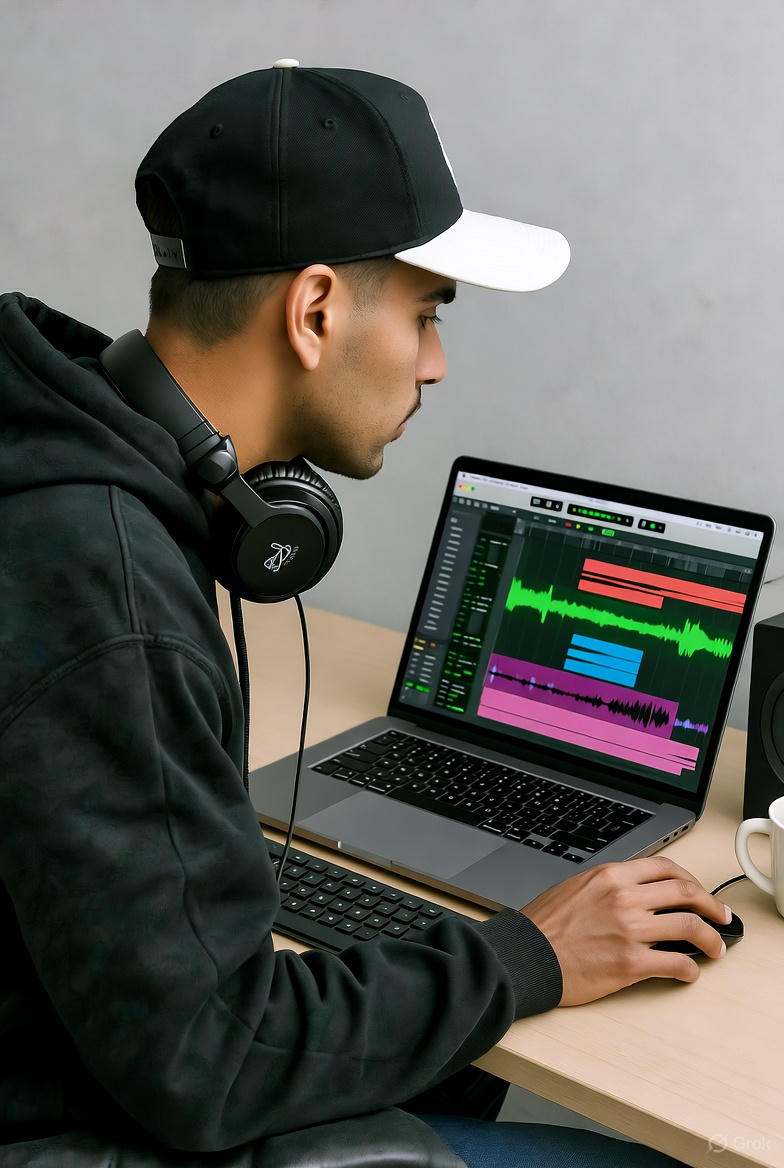!Let Us HELP YOU!
We have a lot of curated content on this blog.
Take this simple 20 second Quiz to Help You
Find The Exact Content You Are Looking For!
Beat mastering may sound like just another step in music production, but it is actually what turns a basic home recording into chart-worthy audio. Here is the shocker: a well-mastered track can sound up to 50 percent louder and clearer on streaming platforms compared to an unmastered version. That ear-catching difference is not magic, it’s precision. Most people think mixing is enough, but skip mastering and even the best beat can fall flat outside your studio.
Table of Contents
-
The Role Of Mastering In Music Production: Enhancing Your Sound
-
Key Techniques In Beat Mastering: Concepts And Their Significance
-
How Mastering Affects A Listener’s Experience: Emotional And Technical Aspects
-
Real-World Applications: Successful Producers And Their Mastering Techniques
Quick Summary
| Takeaway | Explanation |
| Mastering polishes audio for distribution. | Beat mastering transforms raw recordings into professional-sounding tracks ready for various platforms and environments. |
| Focus on frequency balance and dynamics. | Optimizing frequency ranges and managing dynamic range ensure your music sounds cohesive and compelling across playback systems. |
| Advanced techniques enhance sonic quality. | Techniques like equalization, compression, and stereo enhancement improve the overall sound, making it more engaging for listeners. |
| Mastering respects artistic intent. | A skilled engineer amplifies the emotional impact of music while maintaining the original character of the track. |
| Different genres require tailored strategies. | Mastering approaches vary by genre to highlight unique sonic characteristics, enhancing the track’s appeal and suitability across platforms. |
Understanding Beat Mastering: What It Is and Its Importance
Beat mastering represents the critical final stage in music production where raw audio transforms into a polished, professional sound. Unlike basic mixing, mastering is about refining the entire track’s sonic landscape, ensuring consistency, clarity, and commercial-grade quality. When you master your beats, you’re essentially preparing them for distribution across multiple platforms and listening environments.
The Core Purpose of Beat Mastering
Mastering serves multiple essential functions in music production. At its fundamental level, beat mastering balances audio elements, adjusts overall volume levels, and creates a cohesive sound profile. Producers use specialized techniques to:
-
Optimize frequency balance across the entire track
-
Create consistent volume and dynamic range
-
Enhance stereo width and spatial characteristics
-
Prepare tracks for different playback systems
Professional mastering ensures your beats sound excellent whether played on smartphone speakers, high-end studio monitors, or streaming platforms.
This consistency is what separates amateur productions from professional-grade music.
Technical and Creative Dimensions
Mastering is both a technical skill and an artistic process. Sound engineers use advanced tools like specialized mastering techniques to make precise adjustments. These might include subtle equalization, compression, and stereo enhancement that elevate a good beat into an exceptional one.
The goal isn’t just technical perfection but preserving the original creative intent. A skilled mastering engineer understands how to amplify the emotional impact of your beats without losing their unique character. For producers looking to take their craft seriously, understanding beat mastering fundamentals becomes a critical skill in developing professional-quality music.
The Role of Mastering in Music Production: Enhancing Your Sound
In music production, mastering serves as the critical final stage that transforms a good recording into a professional, broadcast-ready track. Think of mastering like the final polish on a diamond, where subtle refinements can dramatically elevate the overall sonic quality and listener experience.
Sonic Landscape Optimization
Mastering goes beyond simple audio adjustment. It involves a sophisticated process of balancing and enhancing the entire sonic spectrum. Professional sound engineers focus on several key objectives:
-
Creating uniform volume levels across different tracks
-
Ensuring consistent tonal balance
-
Maximizing audio clarity without losing dynamic range
-
Preparing music for various playback platforms
The goal is not just technical perfection but maintaining the original emotional essence of the musical piece. Every adjustment is carefully considered to preserve the artist’s creative vision while making the track sound polished and professional.
Technical Precision and Creative Nuance
Sound engineers employ advanced digital tools and years of acoustic expertise to achieve precise mastering results. advanced audio engineering techniques allow them to make microscopic adjustments that can dramatically improve a track’s overall sound. These might include:
-
Fine-tuning equalization to balance frequency ranges
-
Applying subtle compression to control dynamics
-
Enhancing stereo width for a more immersive sound
-
Correcting minor imperfections without losing original character
Mastering is both a science and an art, requiring technical knowledge and intuitive understanding of how sound interacts across different listening environments. A skilled mastering engineer can make a track sound incredible whether it’s played on high-end studio monitors, smartphone speakers, or car audio systems.
Key Techniques in Beat Mastering: Concepts and Their Significance
Beat mastering requires a sophisticated understanding of sound manipulation, where technical precision meets creative expression. Professional mastering involves strategic audio techniques that transform raw recordings into polished, professional tracks capable of captivating listeners across multiple platforms.
Fundamental Mastering Strategies
Mastering engineers employ a series of specialized techniques to optimize sound quality. These strategies focus on creating a balanced, cohesive audio experience that maintains the original artistic intent while enhancing overall sonic clarity:
-
Precise equalization to balance frequency ranges
WEBSITE RESOURCES FOR MUSICIANS
-
Dynamic range compression for consistent volume
-
Stereo image enhancement
-
Harmonic excitement and subtle audio coloration
-
Final limiting to prevent digital clipping
Each technique serves a specific purpose in sculpting the track’s sonic landscape.
The table below compares key mastering techniques, detailing their function and overall impact on the final sound of a track. This helps clarify how each process refines your music and contributes to a professional result.
| Mastering Technique | Main Function | Impact on Sound |
| Equalization (EQ) | Balances frequency ranges across the track | Increases clarity and tonal balance |
| Compression | Controls and evens out dynamic range | Ensures consistent volume without harsh peaks |
| Stereo Enhancement | Widens or focuses the stereo field | Creates a more immersive, spatial listening feel |
| Harmonic Excitement | Adds subtle coloration to enrich tone | Enhances presence and sonic warmth |
| Limiting | Sets maximum output level, prevents digital clipping | Maximizes loudness and maintains technical integrity |
| Multiband Compression | Targets specific frequency ranges for control | Precise sculpting for complex mixes |
| Mid-Side Processing | Adjusts differences between center and sides | Deepens stereo image and spatial detail |
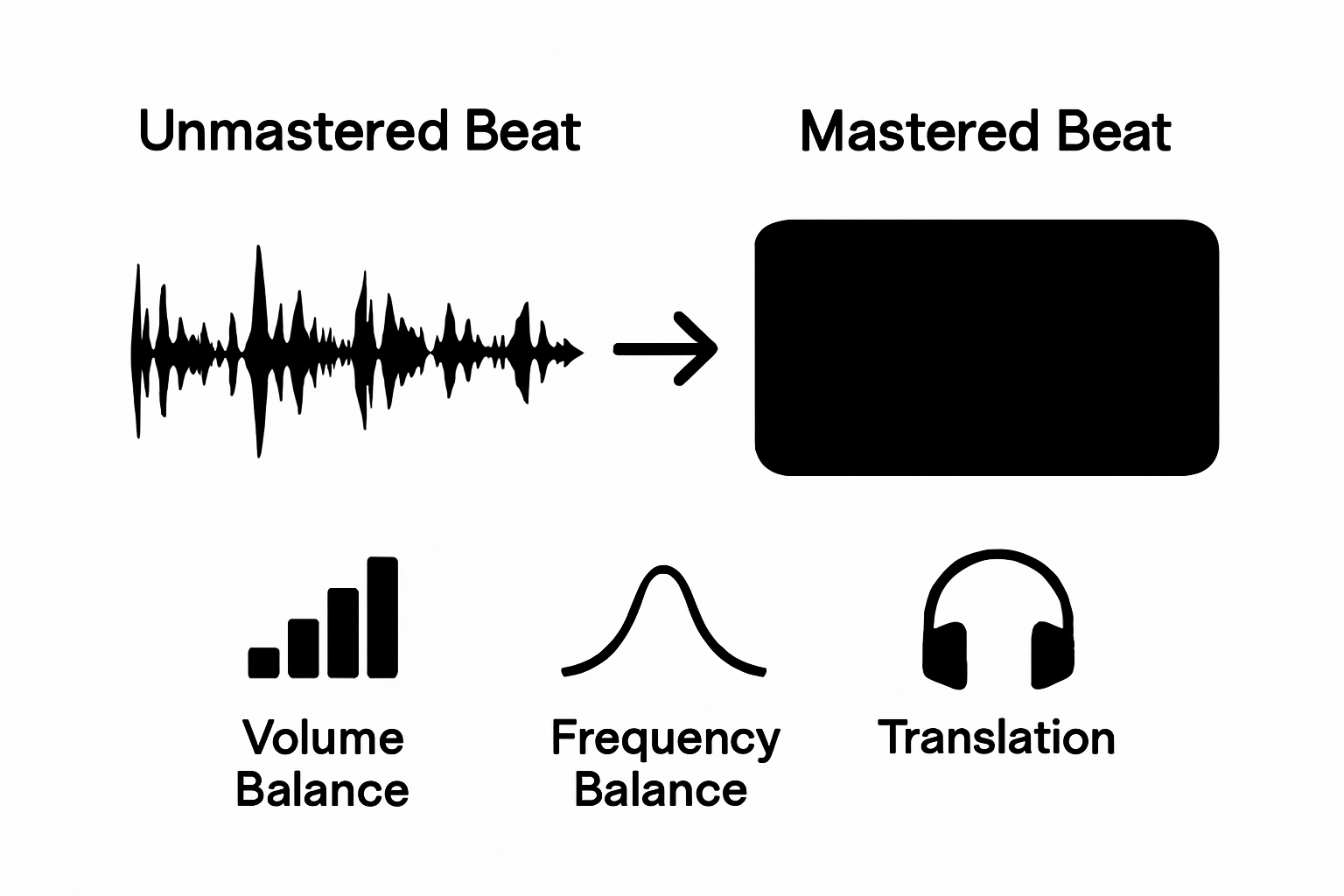 The goal is not to overpower the original mix but to refine and elevate its inherent qualities, making the music sound professional and engaging.
The goal is not to overpower the original mix but to refine and elevate its inherent qualities, making the music sound professional and engaging.
Advanced Sound Sculpting Techniques
Beyond basic audio adjustments, mastering involves nuanced sound engineering approaches. advanced production techniques allow producers to make microscopic improvements that dramatically enhance track quality. Professional mastering might involve:
-
Applying multiband compression for targeted frequency control
-
Using mid-side processing to create spatial depth
-
Implementing subtle harmonic saturation
-
Carefully managing transient response
These techniques require both technical expertise and an intuitive understanding of how different audio elements interact. A skilled mastering engineer can transform a good recording into an exceptional sonic experience, ensuring the track sounds remarkable across various listening environments.
How Mastering Affects a Listener’s Experience: Emotional and Technical Aspects
Mastering transcends mere technical audio adjustment. It represents a nuanced art form that profoundly influences how listeners perceive and emotionally connect with music. The subtle manipulations during mastering can transform a good track into an unforgettable sonic journey that resonates deeply with audiences.
Emotional Resonance Through Sound
Sound engineers understand that mastering is not just about technical perfection but emotional communication. Different audio treatments can dramatically shift a listener’s emotional response:
-
Creating spatial depth that makes music feel immersive
-
Balancing frequencies to enhance emotional clarity
-
Managing dynamic range to control musical tension
-
Optimizing stereo width to create a sense of expansiveness
These techniques work subconsciously, guiding listeners through an emotional landscape without them realizing the intricate sound engineering behind their experience.
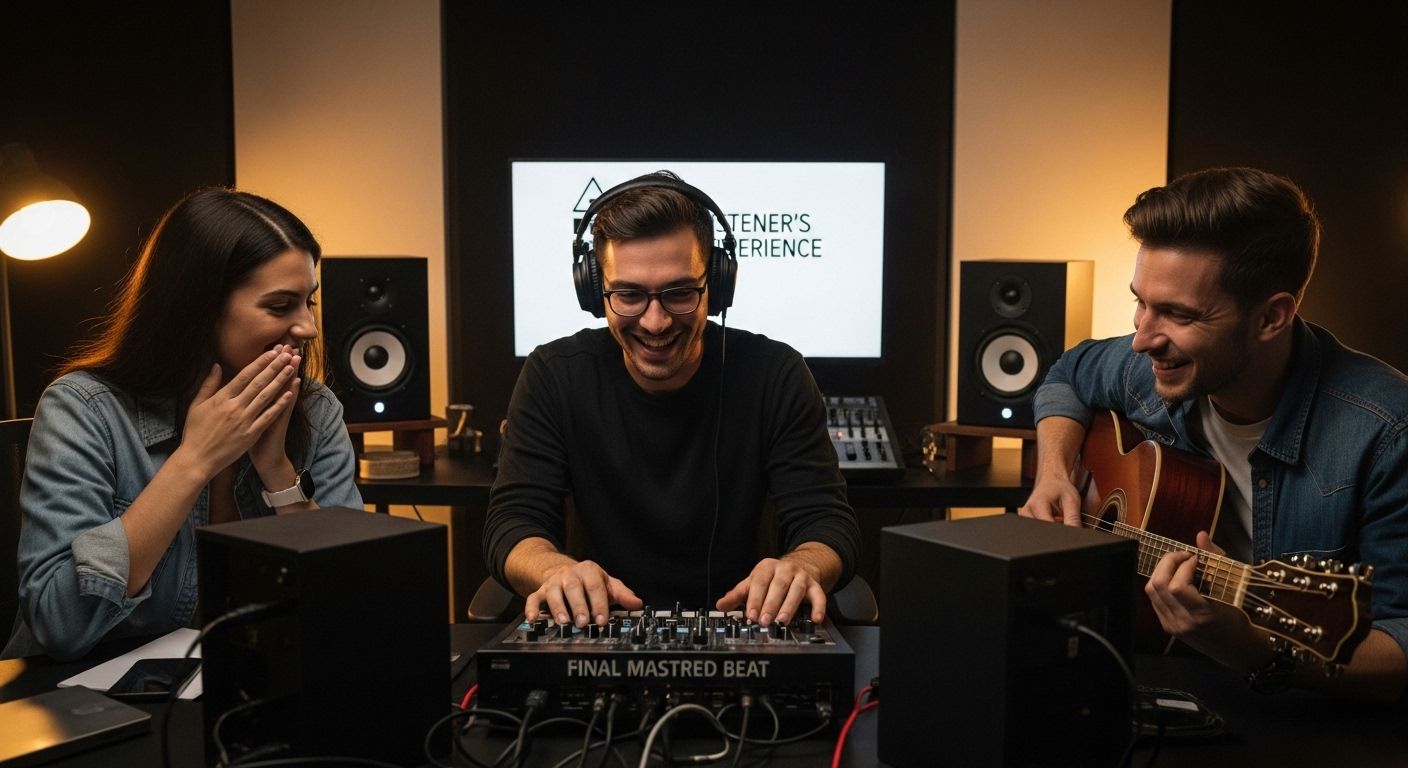 A well-mastered track can make listeners feel more connected, more moved by the music’s inherent emotional narrative.
A well-mastered track can make listeners feel more connected, more moved by the music’s inherent emotional narrative.
Technical Precision Meets Emotional Intelligence
Professional mastering requires an almost intuitive understanding of how sound impacts human perception. advanced audio engineering insights reveal that minute adjustments in equalization, compression, and stereo imaging can profoundly alter a listener’s emotional engagement.
The goal is not just technical accuracy but creating a sonic experience that feels authentic and powerful. By carefully sculpting sound, mastering engineers can enhance the music’s emotional core, ensuring that every frequency and dynamic shift contributes to a more meaningful listener experience.
Real-World Applications: Successful Producers and Their Mastering Techniques
Successful music producers understand that mastering is not a one-size-fits-all process. Each genre, artist, and track requires a unique approach that highlights its distinctive sonic characteristics. Professional mastering transforms raw recordings into polished, industry-standard tracks that resonate across different listening platforms.
Genre-Specific Mastering Strategies
Different musical genres demand specialized mastering techniques that accentuate their unique sonic signatures. Producers develop nuanced strategies to ensure their tracks sound exceptional:
-
Hip hop producers often emphasize low-end punch and clarity
-
Electronic music requires precise frequency balance and dynamic range
-
Rock tracks need aggressive compression and midrange definition
-
Jazz recordings prioritize natural dynamics and spatial representation
These targeted approaches demonstrate how mastering goes beyond technical adjustments, becoming an art form that respects each musical style’s inherent characteristics.
This table highlights how mastering approaches differ across popular music genres, summarizing the specific focus areas and sonic goals for each. Understanding these distinctions can help tailor mastering techniques for your desired style.
| Genre | Mastering Focus | Sonic Goal |
| Hip Hop | Low-end punch and clarity | Powerful bass, crisp percussion |
| Electronic | Frequency balance, dynamics | Clean, impactful, club-ready sound |
| Rock | Compression, midrange definition | Bold presence, driving guitars and vocals |
| Jazz | Natural dynamics, spatial depth | Lively, authentic, open sound |
| Pop | Brightness, loudness | Radio-friendly, energetic, polished mix |
| Classical | Dynamic preservation | Nuanced, articulate, wide dynamic range |
Professional Production Insights
Top-tier producers invest significant time in understanding advanced mastering techniques. professional mastering workflow insights reveal that successful sound engineers approach each track as a unique sonic landscape. They use sophisticated tools and years of experience to make microscopic adjustments that elevate music from good to extraordinary.
The most respected producers recognize that mastering is about maintaining the emotional core of the music while ensuring technical excellence. Their approach involves careful listening, subtle interventions, and a deep understanding of how sound translates across different playback systems.
Ready to Make Every Beat Sound Professional?
You have learned how beat mastering is essential for transforming your tracks from raw ideas into polished, industry-ready productions. But achieving that balance between clarity, emotion, and commercial quality is hard when you do not have the right tools or guidance. Many producers struggle with inconsistent sound across platforms, lackluster dynamics, and not knowing which mastering tricks to use for their specific genre or DAW. Missing that final professional touch can mean your music does not connect with listeners the way you hope.
Take your sound to the next level starting today. Find expert beat-making tutorials and DAW guides, discover unbiased audio gear reviews, or jump into the main site at How To Make Beats Blog for inspiration and actionable steps. Your next big track deserves the best sonic finish, so do not wait—visit now and master your unique sound.
Frequently Asked Questions
What is beat mastering and why is it important?
Beat mastering is the final stage of music production that transforms raw audio into a polished, professional sound. It ensures consistency, clarity, and commercial-grade quality, making your music ready for distribution across various platforms.
How does mastering enhance the emotional experience of music?
Mastering manipulates sound elements to optimize emotional resonance, creating a more immersive experience. Techniques like balancing frequencies and managing dynamic range help convey the music’s emotional narrative effectively to the listener.
What are some essential techniques used in beat mastering?
Essential techniques include precise equalization to balance frequency ranges, dynamic range compression for consistent volume, stereo image enhancement, harmonic excitement, and final limiting to prevent clipping. Each technique aims to refine the track while preserving its artistic intent.
How does genre influence mastering techniques?
Different genres require specific mastering approaches to accentuate their unique sonic characteristics. For example, hip hop may emphasize low-end punch, while jazz prioritizes natural dynamics, demonstrating that mastering is both a technical and creative process tailored to each music style.

